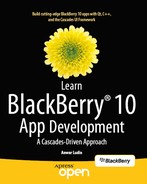Book Description
Learn how to leverage the BlackBerry 10 Cascades framework to create rich native applications. Learn BlackBerry 10 App Development gives you a solid foundation for creating BlackBerry 10 apps efficiently. Along the way, you will learn how to use QML and JavaScript for designing your app's UI, and C++/Qt for the application logic. No prior knowledge of C++ is assumed and the book covers the fundamental aspects of the language for writing BlackBerry 10 apps. Also a particular emphasis is put on how to create a visually enticing user experience with the Cascades framework, which is based on Qt and QML.
Starting with the native SDK configuration and an overview of the Momentics IDE, the book is fast-paced and you will rapidly learn many of the best practices and techniques required for developing beautiful BlackBerry 10 apps.
Learn BlackBerry 10 App Development is written for developers wishing to learn how to write apps for the new BlackBerry 10 OS and those interested in porting existing iOS and Android apps to BlackBerry 10 as native applications.
What you'll learn
How to design and create native BB10 applications using the declarative expressiveness of QML
How to master the Cascades framework and the core BB10 UI components
How to use C++ and Qt efficiently with Cascades
How to utilize the BlackBerry Momentics IDE to launch and debug your applications
How to apply the fundamental aspects and best practices of BB10 application design
How to use HTTP networking in order to leverage remote services
How to integrate your application with BlackBerry 10 core apps such as the Contacts and Calendar apps
How to send email and short text messages from your app
How to use your device's camera and sensors such as the accelerometer and gyroscope
Who this book is for
BlackBerry developers wishing to write native BB10 applications, game developers. iOS and Android developers wishing to port their apps to BB 10.
Table of Contents
- Title Page
- About ApressOpen
- Dedication
- Contents at a Glance
- Contents
- About the Author
- About the Technical Reviewers
- Acknowledgments
- Introduction
- Chapter 1: Getting Started
- Chapter 2: QML and JavaScript
- Chapter 3: C++, Qt, and Cascades
- Chapter 4: Controls
- Chapter 5: Application Structure
- Chapter 6: ListView and DataModel
- Chapter 7: HTTP Networking
- Chapter 8: Personal Information Management APIs
- Chapter 9: Sensors
- Chapter 10: Invocation Framework
- Appendix: Device File system
- Index
